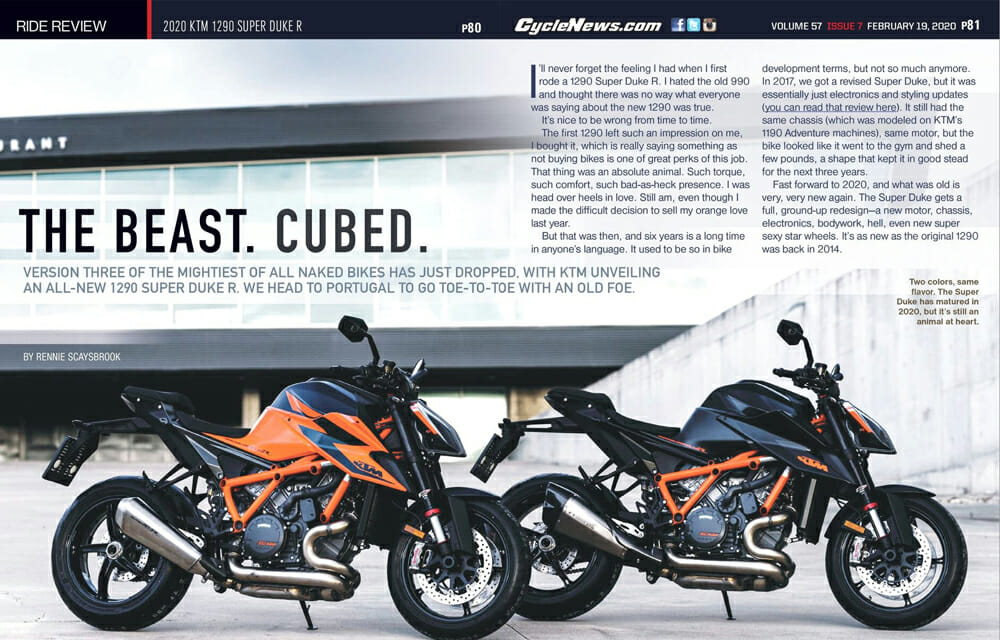Rennie Scaysbrook | February 21, 2020
Version three of the mightiest of all naked bikes has just dropped, with KTM unveiling an all-new 1290 Super Duke R. We head to Portugal to go toe-to-toe with an old foe.
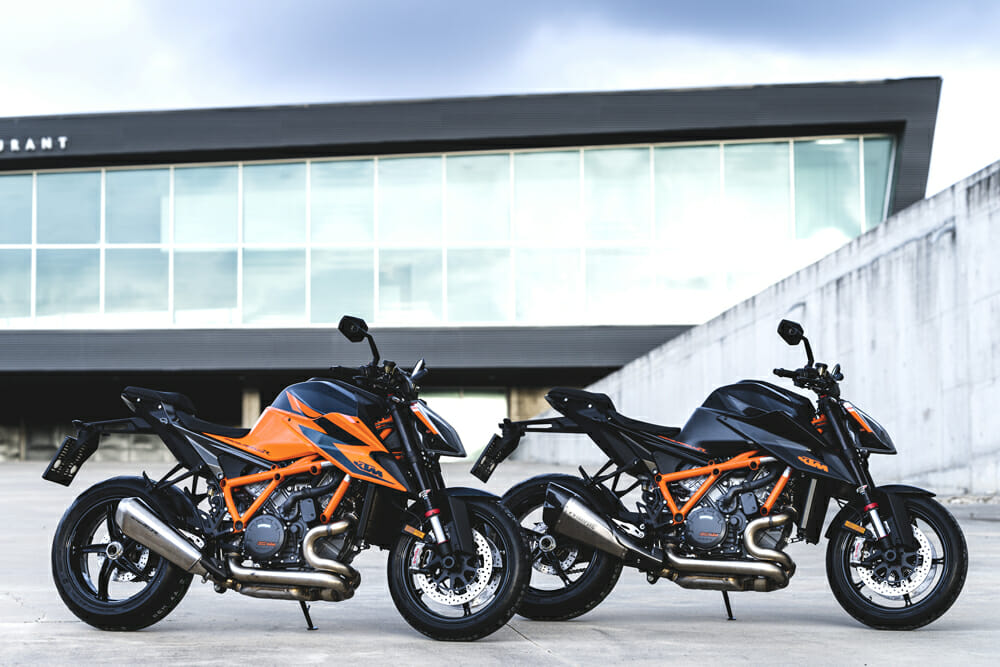 Two colors, same flavor. The Super Duke has matured in 2020, but it’s still an animal at heart.
Two colors, same flavor. The Super Duke has matured in 2020, but it’s still an animal at heart.
I’ll never forget the feeling I had when I first rode a 1290 Super Duke R. I hated the old 990 and thought there was no way what everyone was saying about the new 1290 was true.
It’s nice to be wrong from time to time.
The first 1290 left such an impression on me, I bought it, which is really saying something as not buying bikes is one of great perks of this job. That thing was an absolute animal. Such torque, such comfort, such bad-as-heck presence. I was head over heels in love. Still am, even though I made the difficult decision to sell my orange love last year.
But that was then, and six years is a long time in anyone’s language. It used to be so in bike development terms, but not so much anymore. In 2017, we got a revised Super Duke, but it was essentially just electronics and styling updates (you can read that review here). It still had the same chassis (which was modeled on KTM’s 1190 Adventure machines), same motor, but the bike looked like it went to the gym and shed a few pounds, a shape that kept it in good stead for the next three years.
Fast forward to 2020, and what was old is very, very new again. The Super Duke gets a full, ground-up redesign—a new motor, chassis, electronics, bodywork, hell, even new super sexy star wheels. It’s as new as the original 1290 was back in 2014.
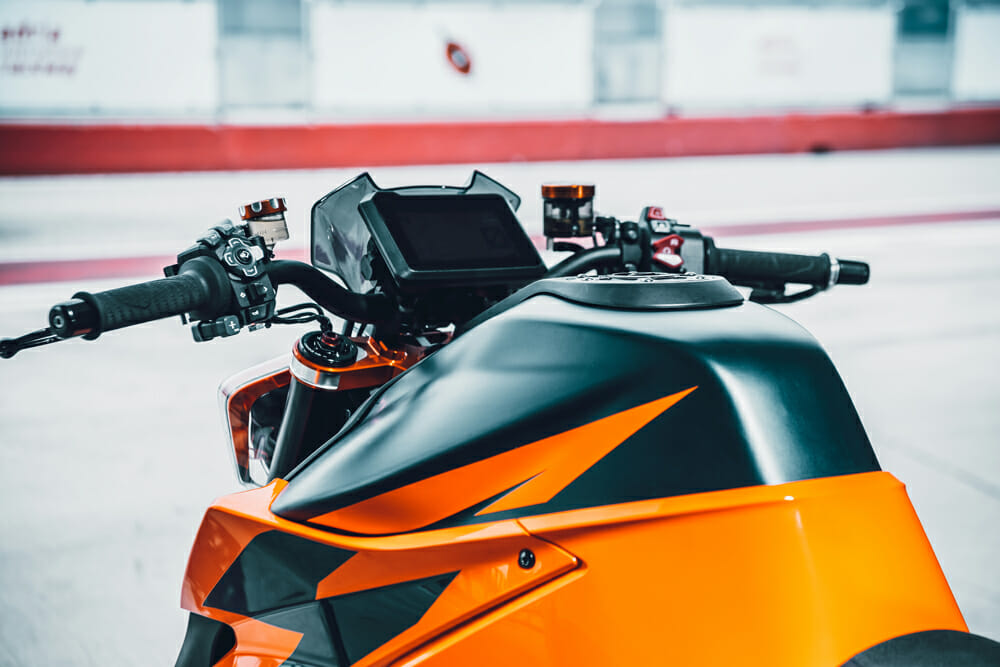 Mission control for the Super Duke. The bar is now a touch lower than before, helping put more weight on the front.
Mission control for the Super Duke. The bar is now a touch lower than before, helping put more weight on the front.
2020 KTM 1290 Super Duke R Review | The Motor
For 2020, KTM and the design team at Kiska went firmly back to the drawing board when dreaming up the new Super Duke. But one fact, or rather, two, remain. Although the motor has been reworked, it still produces the exact same number of horsies and torque-ies as in 2017, with 177 horsepower at 9500 rpm and 103 ft.-lbs. at 8000 rpm of torque. The 2017 edition would hit peak power at 9750 rpm and peak torque at 7000 rpm.
The output may be the same but the motor has changed. Still measuring 1301cc, KTM’s fitted twin shower injectors for the first time, replacing the single injector setup previously used. The 56mm throttle bodies remain, although the airbox has been extensively reworked and now features an intake that sits either side of the steering head.
Previously, the intake sat either side of the bodywork, and was more than a bit of a pain to line up when refitting the plastics (I should know). Now the intake is front and center, wrapping itself either side of the steering head, and KTM has used the same split the headlight down the middle, allowing as much air as possible into the chamber and thus the more compact cylinder heads.
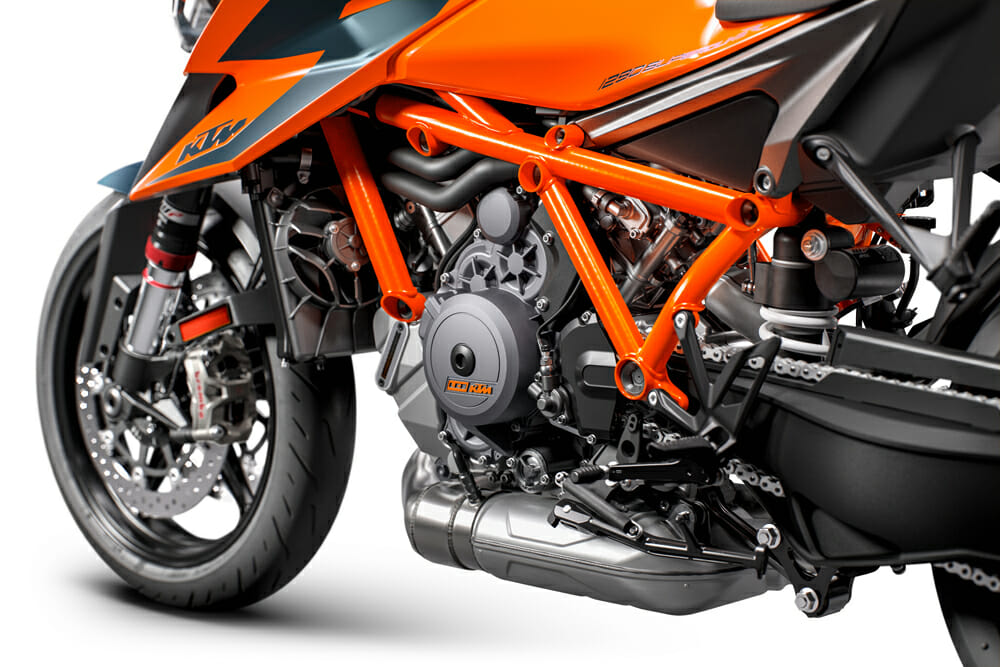 Despite having an extra catalytic convertor added, the overall exhaust weight has been dropped by 2.2 pounds.
Despite having an extra catalytic convertor added, the overall exhaust weight has been dropped by 2.2 pounds.
Inside the airbox sits new fixed intake resonators, designed to help smooth out the initial kick below 5000 rpm. The dual spark ignition remains, with new coils fitted for a cleaner spark.
With the heads being squished down, the overall piston size has been slightly reduced, all helping to decrease oscillating mass within the motor. The crank itself has been slightly beefed up on the generator side for better stability, although the engineers have been able to trim a very respectable 800 grams off the crank mass.
The gearbox has been given an overhaul for a shorter and lighter shift via a machined splined shaft and new bronze and copper coating on the shift forks. Plus, the gearshift is now reversible for race or road shift easily, and you can get a quickshifter from the PowerParts catalog.
Externally, one of the biggest changes for the motor has been the new exhaust. The previous generation SD had only a single catalytic convertor, but the boffins who charge out Euro 5 rules have dictated a second cat needed to be fitted if the 2020 bike was to pass regulations. Despite this, the now 54mm front and 60mm rear header pipe system weighs a claimed 2.2 pounds less than in 2017, for a total weight of 22.49 pounds.
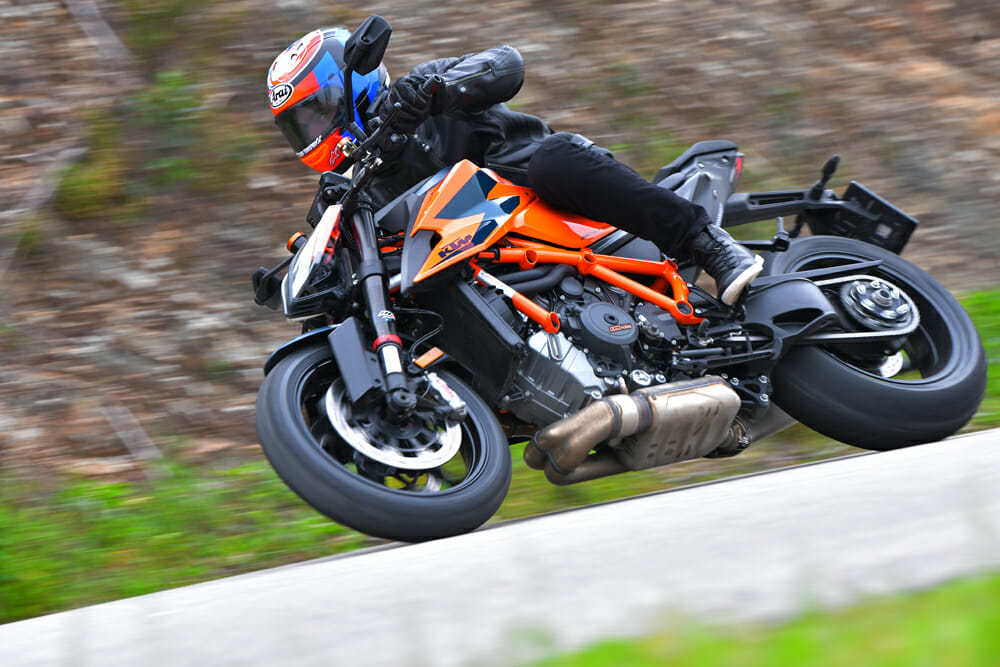 KTM doesn’t make a sport bike, or so they say! The Super Duke is about as sporty a bike as you’ll ever need for the street.
KTM doesn’t make a sport bike, or so they say! The Super Duke is about as sporty a bike as you’ll ever need for the street.
2020 KTM 1290 Super Duke R Review | The Chassis
By far the biggest difference between the 2017 Super Duke and the one you see before you is the chassis—it’s orange and made from steel, but that’s about where the similarities end.
Stiffness, or rather, an increase in stiffness was the name of the game for 2020. The motor sits 38mm higher and is used as a stressed member of the chassis as usual but features a new downtube either side the front of the motor to help increase stiffness three times over the 2017 model.
The engineers have raised the center of gravity and reduced the fork offset by 3mm thanks to the new, 800-gram lighter triple clamps, giving a sharper feel from the front-end under braking and cornering.
At the rear, the lighter single-sided swingarm has been retained but is now 15 percent stiffer than before, again in the aid of better lean-angle stability and feel. It’s the same length as before but sits five millimeters higher on the frame to give better anti-squat characteristics—essentially to stop the rear from sagging when you get hard on the gas and eventually running wide.
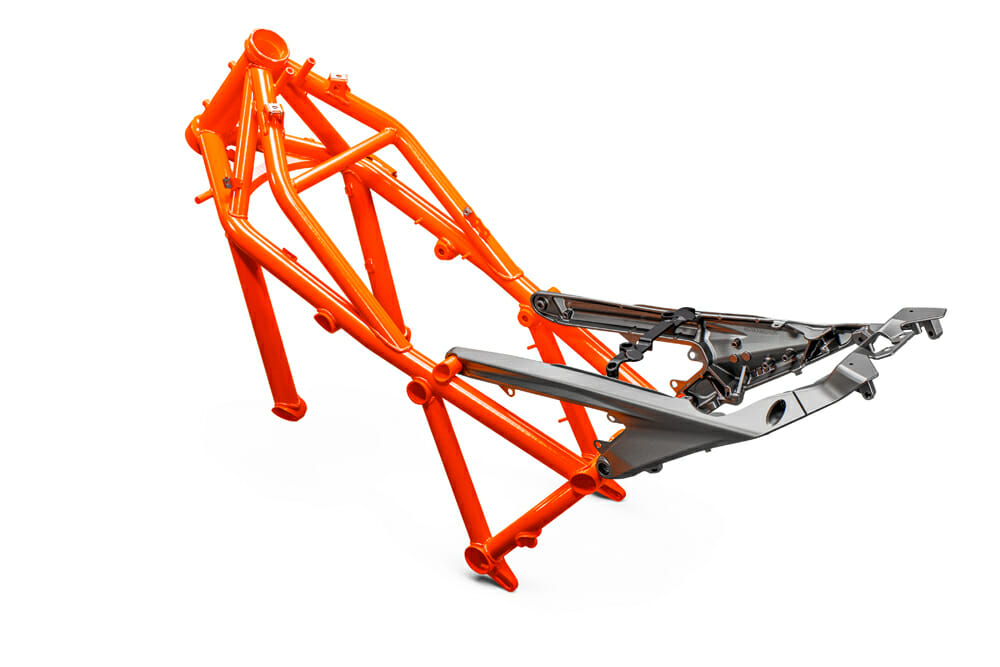 The 2020 chassis with the long front downtubes, versus the 2017 edition (below). Note how much beefier the new frame is!
The 2020 chassis with the long front downtubes, versus the 2017 edition (below). Note how much beefier the new frame is!
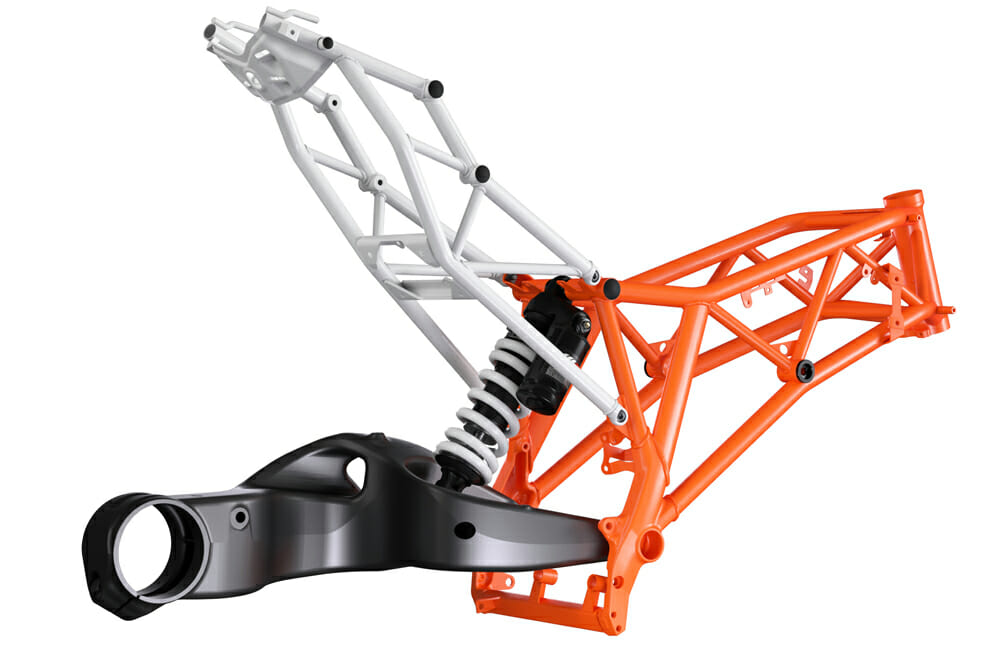
One of the signature Super Duke features is now gone, as the exposed tubular steel subframe makes way for a die-cast aluminum unit which saves a claimed 3.3 pounds. Those with a keen SD eye will notice this is the same unit found on the little brother 790 Duke, which debuted last year.
On the suspension side, the WP APEX fork retains the split system (compression damping adjustment on the left, rebound on the right), but fork now comes with preload adjustment for the first time.
On the rear, the shock is fully adjustable with a handy remote preload dial. But, crucially, the shock now uses a linkage system rather than operating directly off the swingarm, with the end results being a much more supple feel from the back when on the road.
Stopping the beast up front are new Brembo Stylema calipers—the same as on the Ducati Panigale V4 S, for example—with new 500-gram lighter five spoke “star” wheels fitted. These are wrapped in Bridgestone’s S22 rubber (you can read the test of these tires here), with a new rear tire made especially for the Super Duke. The belt construction is softer than what you’d get on a base model S22 and offers not just incredible grip but amazing longevity. Case in point: Bridgestone didn’t change the tires after a full day at Portimao, meaning each front and rear tire would have done at least 12 20-minute sessions, with plenty of grip and life still on offer. A golf clap to Bridgestone, please, ladies and gentlemen.
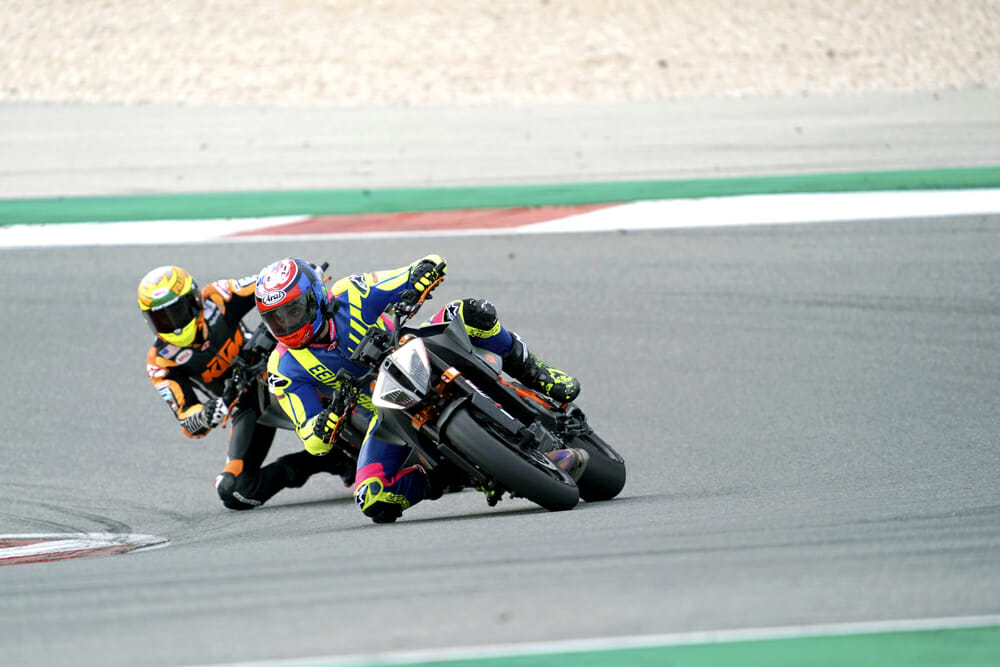 Rennie hounded by his old KTM teammate Chris Fillmore. Chris got by, unsurprisingly easily.
Rennie hounded by his old KTM teammate Chris Fillmore. Chris got by, unsurprisingly easily.
2020 KTM 1290 Super Duke R Review | The Electronics
When I look back at my 2015 model SD, it looks positively archaic compared to what’s on offer now. I had three riding modes, heated grips and Supermoto mode on the ABS, Motor Slip Regulation (MSR), and on/off traction control. That’s it.
Now, KTM has fitted five possible riding modes (Rain, Street and Sport as standard fitment, Track and Performance with the aftermarket Track Package), cruise control, wheelie control, nine-stage adjustable traction control, Cornering ABS with Supermoto mode (disconnecting rear ABS but keeping it on the front to, you know, back that baby in), optional quickshifter (you’ll want this), and you can preset two modes of all your settings via the admittedly clunky looking switch atop the right handlebar.
And for the first time, the SD runs a six-axis IMU (the old one was a five-axis unit), which holds a version of the same Slide Control algorithm first seen on the 2015 Yamaha YZF-R1. However, turn the ABS off and you also lose the lean-angle sensor at the rear and thus the Slide Control, which is odd given the only reason you’d want to turn the ABS off is if you were really going for it at the track—the place Slide Control is best suited.
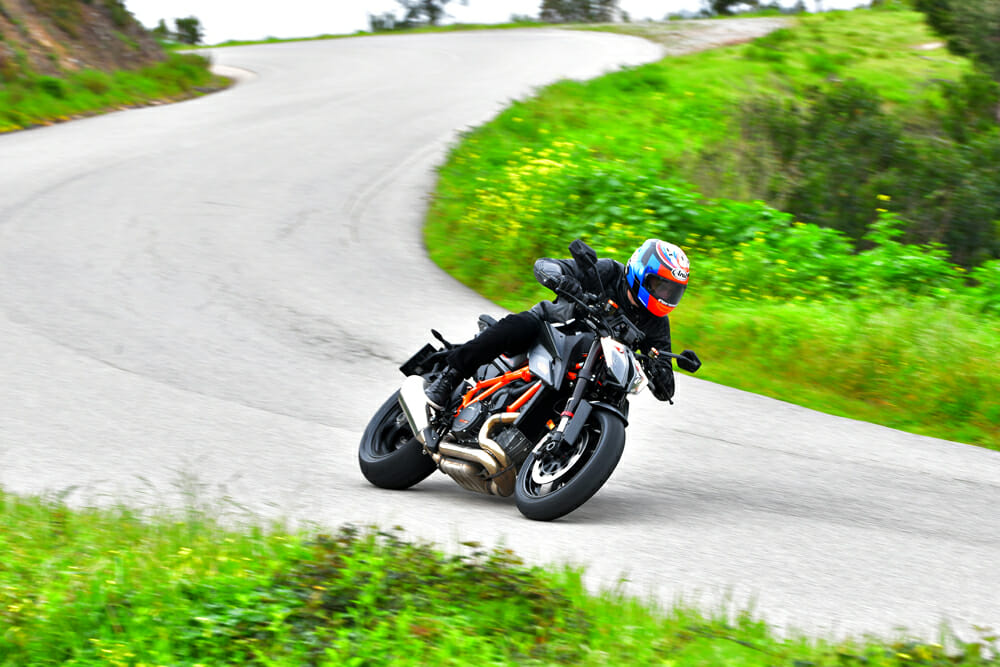 Twisty roads are such a joy on the Super Duke. The raised center of gravity and the new shock make tight roads like this a dream.
Twisty roads are such a joy on the Super Duke. The raised center of gravity and the new shock make tight roads like this a dream.
The modes work with preset traction control numbers (until you go into Track and Performance, where you can vary the levels). But if you do go into Track or Performance, you’ll lose the Motor Slip Regulation—the system that electronically governs engine braking.
Everything is accessed via the five-inch TFT display, and there’s more switches on both sides of the handlebar than you can poke a stick at. They look almost military and certainly not very pleasing to the eye, however, I’m still all for them as the switches are there and the information easy to access, rather than having one switch that does it all and you having to navigate your way through the electronics solely via the dash.
As before, you can utilize the MyKTMnavigation app that pairs your phone to the bike and lets you navigate everything via the dash from taking calls and messages, to running the onboard navigation.
Chatting with the Super Duke’s Dad, Herman Sporn
If it were not for Hermann Sporn, perhaps the Super Duke would never have emerged. Hermann has been the project leader of the Super Duke since its inception and he’s likely forgotten more about The Beast than most of us will ever know.
We caught up with him for a quick chat at Portimao.
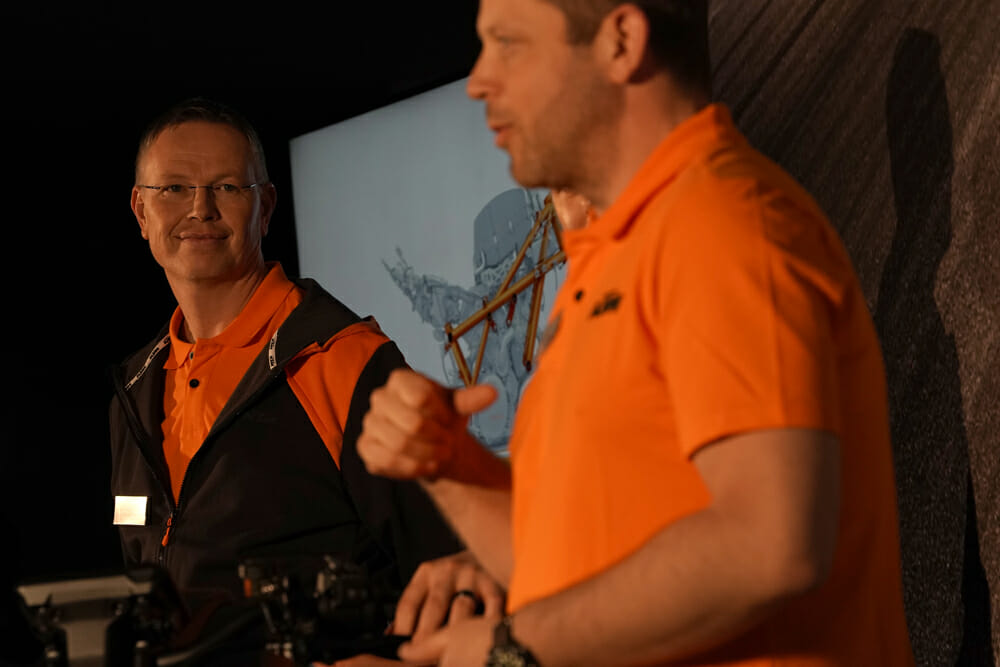
There are such a huge amount of changes with this bike. Talk us through the chassis updates.
We know from the old Super Duke that we have not the right anti-squat behavior. This was the reason why we had to adjust the chassis, so we don’t have this running wide out of the corner. The bike needed to be stable, that the weight transfer is not so much to the rear. It means when you accelerate hard out of the corner, that you can stay your line.
Additionally, when you bring up the center of gravity to the level, we have you get a better handling. This was what we have done for the rear and we get more control for it. But what was also really important is we knew also our frame was really a soft frame, or a supermoto frame, that was not really correct for racetrack behavior.
This was the same frame KTM used on the Adventure bikes, correct?
On the first Super Duke, it was more or less the same. The Adventure chassis was a little bit shorter, and a little bit stiffer, but it was not enough when you have the higher amount of forces you have to withstand, so we gave the chassis more torsional stiffness.
With the new chassis, we have increased the torsion stiffness three times over. This helps to get better feedback from the front.
Additionally, we have now two engine hangers, that means we can adjust the torsional stiffness of the chassis. This is really important. At maximum lean angle, the suspension doesn’t work so good. At this lean angle, you need a good behavior from the chassis so that it works from the front and for the stiffness for the swingarm you have to have the feeling from the rear. Additionally, it’s important that you have the right amount of stiffness from the rims. Altogether it gives a package where you have the safety feeling on the road. You know every time what is happening with the front tire. If it’s slippery, if you have grip, you can push, or you have to go back. It helps you on the street, but also on the track. On the track, it’s really important when you go to the maximum that you feel what the tire is doing.
The swingarm is the same length as it was before, but it’s now raised up higher in the chassis?
The pivot is higher. Additionally, we have also changed stiffness on the swingarm. We did it without increasing the weight. The reason is that the brace we had before on the top, we put to the lower end. The neutral point is lower. That means with the same stiffness from the swingarm, we have less movement on the tire. That helps you a lot.
And the engine is now 38mm higher in the chassis?
Yes, engine is 38mm higher, and an additional five millimeters we have lifted the swingarm pivot in the engine. So, for a total of 43mm.
The shock itself is not shorter. The shock is the same length, but it has more travel?
It is completely the same length. The main difference we have is before we have only 57mm shock stroke, with the direct link to the swingarm. Now we have changed to a linkage. The linkage gives you much more possibilities to adjust to the right amount of shock progression. Also, this affects how the movement is on the shock is with more bumps on the street.
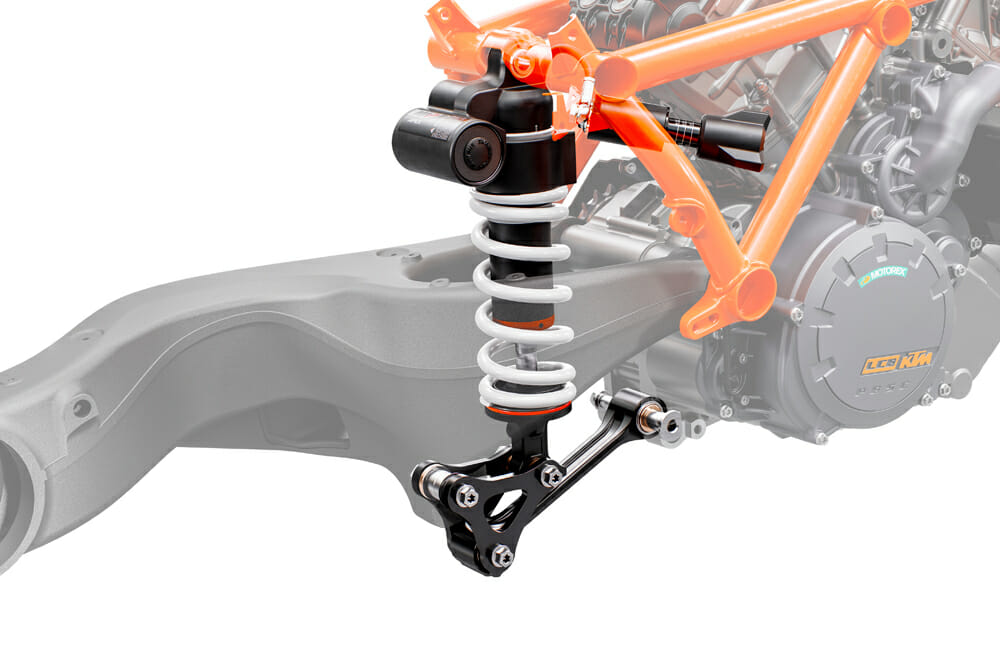 The shock now works off a linkage, and the ride quality is all the better for it.
The shock now works off a linkage, and the ride quality is all the better for it.
What’s different with the front?
We now have a fork offset of 32mm instead of 29mm and new triple clamps. Then on the fork we have now a preload adjuster. We have an aluminum cartridge, and the aluminum cartridge is also bigger than before. This also helps for a better response from the front.
You start looking at the motor as well. Now we have 90 percent or 80 percent of torque at 3000 rpm, something like that?
Yeah. This is what you need for the road. When you have a motorcycle where you have the torque at maximum rpm, also the maximum power, this is as we know, when you are in these revs, with the second gear, you were somewhere over the speed limit.
Here on the Super Duke you have also the possibility to drive with third gear with a midrange torque from 114 Nm (84 lb-ft) at 4500 revs, and you have always the right amount of torque. That means when you ride on the road, you never know how the curves are, if you need this gear or this gear. With the Super Duke it makes no matter!
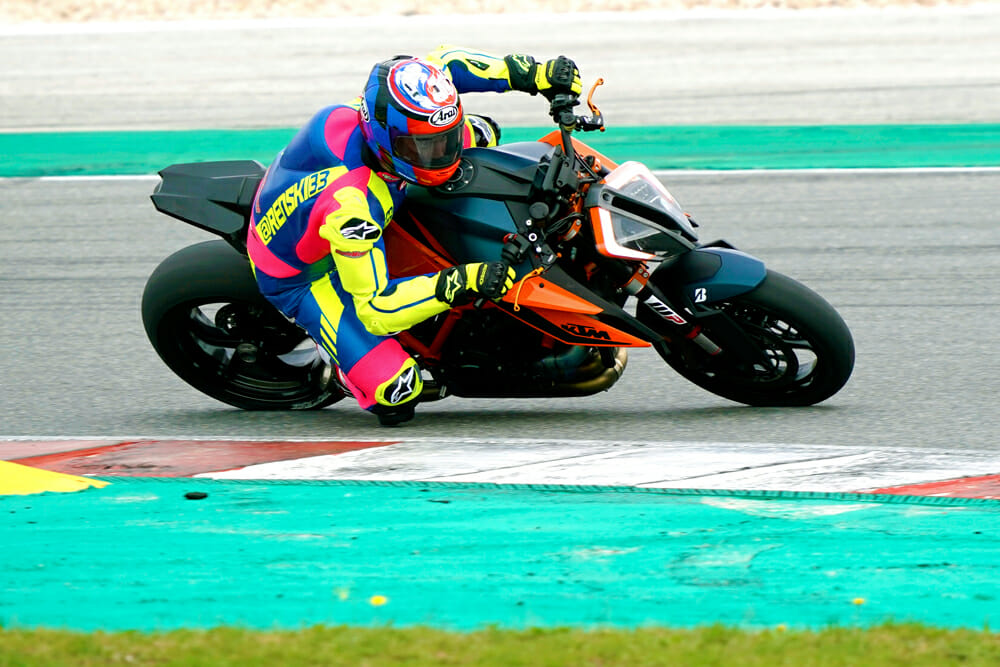 Rennie aboard the PowerParts bike. With that exhaust, WP race-spec suspension, Bridgestone V02 slicks and taller and more rearward rearsets, everything the Super Duke is good at gets ratcheted up a few notches.
Rennie aboard the PowerParts bike. With that exhaust, WP race-spec suspension, Bridgestone V02 slicks and taller and more rearward rearsets, everything the Super Duke is good at gets ratcheted up a few notches.
2020 KTM 1290 Super Duke R Review | From the Hotseat
The 1290 Super Duke and I have a long history. Three times on two different models I’ve raced one up Pikes Peak, once on my old 2015 model and twice on a 2017 edition, but I had not even sat on one since I took a close second to Carlin Dunne in 2018.
That first feeling of bum-on-seat was just like meeting up with an old flame. Only one that had been to the gym while you were out frolicking with other girls.
VIDEO | 2020 KTM 1290 Super Duke R World Launch and Review
Our first half of the day in Portugal was on the street, perfect given the dreary fog that caked the Portimao hills. Immediately you can feel this third edition of The Beast is more slanted towards its nose—the handlebar is slightly lower and more forward than in 2017 and puts you in more of an attack position for corner entry.
But you lose none of the long-distance comfort in the new riding position. The tank is wider, and the seat foam a touch firmer, which is a good thing in my book as your ass doesn’t sink into the seat during a long ride.
There’s plenty of ways you can change the ride position—the handlebar can be moved into one of four positions with a 22mm range of movement, the brake and clutch levers are span adjustable and the pegs can be moved on an eccentric so you’ll always be able to find the right setting.
Immediately, you’re smacked in the face by the stupendous low-end torque from the 1301cc four-stroke. At traffic speed, you barely need to go out of 4000 rpm, short shifting your way up the massive torque curve and letting the motor pull you from corner to corner. Throttle response at this speed is simply beautiful and belies the fact you have so much immediate go underneath you.
Wind it up, however, and things start happening very quickly. Hunched over the front, you begin gunning for apexes in a much more purposeful fashion than on the 2017 Super Duke. It’s not as though the 2020 bike feels completely different, it’s just tighter, more direct in everything it does.
It takes days to work out the dash and all the various functions within it. If it were my bike, I’d figure out my setting and leave it there, because you can very easily get lost on the range of electronic adjustment. One thing desperately annoying is when you simply kill the motor (let alone switch off the ignition), the electronics default to the base settings for throttle, traction control, wheelie control, ABS, etc. Having to constantly rewire my own settings drove me nuts.
The suspension action on the street is brilliant. It’ll soak up almost anything you can throw at it, and because you’re in an almost dirt-bike riding position, whatever whack you get doesn’t feel as harsh as if you were on a proper sport bike.
The rear suspension is especially impressive, with a softer and suppler feel over rough bumps and g-outs that’s surely a by-product of the new linkage system.
Move to the track, and that new rear suspension advantage really shines through. During our Pikes Peak years, much time was spent trying to get the bike to finish off the corner, to allow the rider to essentially point and squirt the bike.
You can busy the front of the Super Duke into corners better than previously. The extra weight on the front allows you to really push the chassis on corner entry and not rely on using the rear brake to settle the bike as much as the 2017 model. You can be far more aggressive on the 2020 model than you’d believe.
The new Super Duke does this much better than my old race bike did, which was equipped with all the KTM/WP PowerParts suspension I could get on it. The chassis doesn’t sink down in the rear stroke like before, and you can really boss the thing on the gas harder than previously.
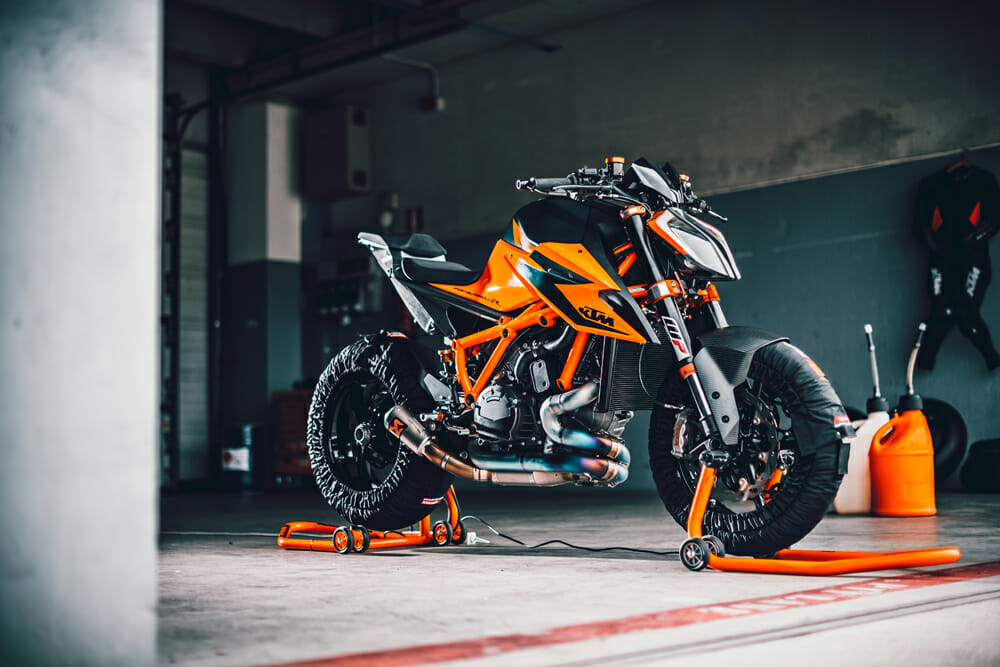 The PowerParts racebike. It’s as rad as it looks. That exhaust alone is worth the price of admission.
The PowerParts racebike. It’s as rad as it looks. That exhaust alone is worth the price of admission.
We had a few laps on a full race-bike build, one with a plethora of KTM PowerParts including an Akrapovic exhaust, WP race suspension and Bridgestone slicks. I tell you now, I’d take that thing to America’s Mountain in a heartbeat. Everything the base model did, this bike did twice as good. Braking stability was excellent, mid-corner throttle response was improved, and the grip on offer from the chassis and Bridgestone slicks was amazing. It was genuinely difficult to fault.
The track highlighted just how good the electronics package on the Super Duke is. With traction control set to level four of nine, it gave the SD just enough to slide the tire predictably but still keep everything going forward as hard as possible. The cut in was minimal, and when matched to the direct response you get in the Track throttle mode, you get absolutely everything the Super Duke can offer.
I switched the wheelie control off on the track, simply to let the Super Duke have its head more on acceleration. The wheelie control however is one of the better systems out there, as it’ll let you carry a wheelie a fair way out of the corner before the fun police kick in and pull the wheel down.
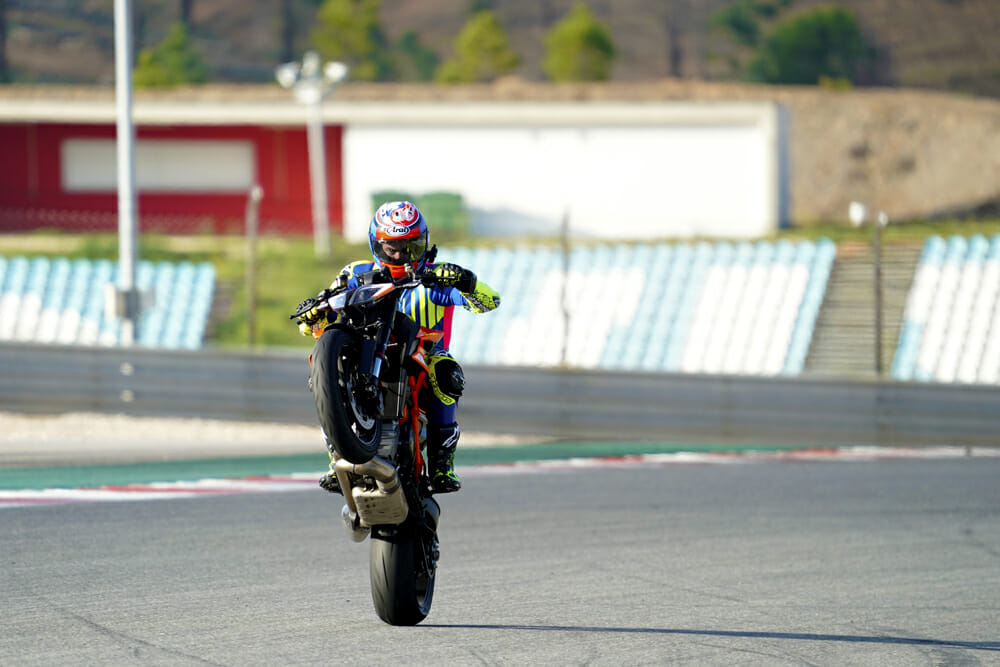 Switch off the wheelie control, and you can do this stuff all damn day on a Super Duke. It’s just too easy.
Switch off the wheelie control, and you can do this stuff all damn day on a Super Duke. It’s just too easy.
With regards to the motor, it’s nothing you don’t already know. There’s bucket loads of torque, but it doesn’t reach to stratospheric levels. Keep the motor twisted in the 7-9000 rpm range when really going for it, and you’ll be rewarded with plenty of top-end acceleration—far more than what could have been considered possible for a big twin 10 years ago. It’s smooth in its delivery, but I must admit, I kept the throttle mode in Street for most of the time on track, including when I rode the race bike. Street mode allows for a softer hit of torque than in Track or Performance, which, when you’re on the side of the tire, is a welcome trait.
KTM’s 1290 Super Duke R is absolutely one of the best naked bikes in the world, possibly the best of all. In the 2020 edition, you’ve got a bike that’s gone through adolescence and matured somewhat but is still a beastly brat at heart.
I loved my 2015 edition almost as much as my own son, but the 2020 is just plain better everywhere. The changes made have equaled a more complete package, and one that will put the model in good stead for many years to come. CN
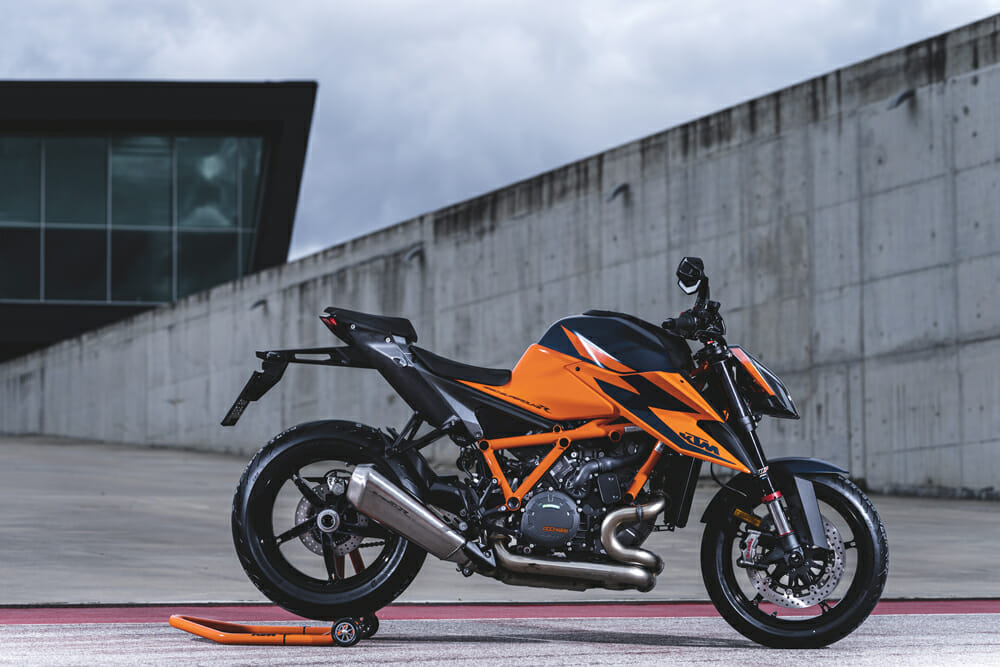
2020 KTM 1290 Super Duke R Specifications
| MSRP: |
$18,699 |
| Engine: |
75° V-twin |
| Power: |
177 hp at 9500 rpm |
| Torque: |
103 ft.-lbs. at 8000 rpm |
| Displacement: |
1301cc |
| Bore x stroke: |
108 x 71mm |
| Compression ratio: |
13.5:1 |
| Fuel system: |
Keihin EFI, 2 x 56mm throttle bodies |
| Exhaust: |
2-2-1 |
| Transmission: |
6-speed |
| Chassis: |
Chromium-Molybdenum-Steel trellis frame, powder coated |
| Front suspension: |
48mm APEX inverted fork, fully adjustable |
| Rear suspension: |
WP shock, fully adjustable |
| Front wheel travel: |
4.9 in. |
| Rear wheel travel: |
5.5 in. |
| Front brake: |
Brembo Stylema Monobloc 4-piston, radially mounted caliper, 320mm disc; ABS |
| Rear brake: |
Brembo 2-piston, fixed caliper, 240mm disc; ABS |
| Front tire: |
120/70 ZR17 |
| Rear tire: |
200/55 ZR17 |
| Head angle: |
64.8º |
| Trail: |
4.17 in. |
| Wheelbase: |
58.9 in. |
| Seat height: |
32.8 in. |
| Fuel capacity: |
4.23 gal. |
| Weight (claimed, dry): |
416 lbs. |
| Colors: |
White/Orange, Black |
